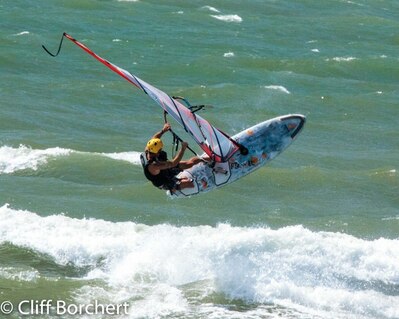|
|
Bio - Eric L. Mihelbergel is an intermediate/advanced windsurfer, kiteboarder, and foiler living in the Great Lakes Region of New York State who enjoys sharing about windsports and fitness.
|
Jumping: In or Out of the Harness? (Windsurfing)
By Eric Mihelbergel (Written January 2019)
What is the difference between jumping hooked-in versus not hooked-in? This is a question worth discussing.
I've been windsurfing for 9 years. During the first 7 years I could only jump well while hooked-in to the harness. Only in the last 2 years have I learned to jump well while not hooked-in. Does that mean it is more difficult to jump not hooked-in? Well, for me it was, but that is not the case everyone. For some people it is more natural to jump not hooked-in and for others it's more natural hooked-in. There is no right way, but let's talk about the differences.
In my early years, I remember trying to jump unhooked, but my forearms just were not strong enough to hold on without immediate fatigue. That was one of the biggest reasons that I learned to jump hooked-in. Whenever I unhooked, my power would die because my forearms couldn't sustain grip on the boom. This weakness in my forearms affected other areas of windsurfing as well. It was difficult riding in cold conditions with thick mittens. Jibing was difficult being out of the harness. Attempting frontside riding was very difficult as well being out of the harness. Around year six or seven I purchased smaller diameter booms that were 24.5mm. This helped some, but the biggest difference was simply years on the water to build forearm strength specific to windsurfing. It didn't matter that I had years of forearm strength from competitive sprint kayaking. It didn't matter that I did considerable forearm training in the weight room. For me, the strength was totally different for windsurfing. It just took time to build that strength so I could ride unhooked.
My greatest inspiration for jumping in my early years was one of our local riders, Jeremy Myers. Jeremy has always made 10 foot jumps look so smooth, easy and effortless. He never loses a stride and planes away as though he is simply sailing through the air for a few moments. I remember asking Jeremy if he jumped in or out of the harness. He replied that he mostly jumped out of the harness. It is generally more common for windsurfers to jump not hooked-in. But, recently, I read an article where David Ezzy talked about teaching his son, Graham, to jump when he was young. The article explained that David continually tried to teach Graham to jump unhooked, but Graham naturally jumped in the harness. He has become a very good pro windsurfer in the process. So, you see, there is not necessarily a "correct" way to do it. But by discussing it here we can see the differences.
There is a different technique when jumping hooked-in compared to unhooked. Early on, I found that if I stayed hooked-in, I didn't lose any power in the sail, AND I was able to leverage pop off the harness through the boom. As you approach your ramp, bend your knees. This does two things. First, it loads the sail with power as the downward pressure of your hips pulls down on the boom through the harness and forces you to sheet in a bit. Second, your bent knees are now loaded and ready to spring off the peak of the wave. So, bend those knees as you approach your ramp. Once you are airborne, pull your knees up toward your chest and pull the sail down toward you so that you and your kit are compact. At this point you may or may not come out of the harness. It depends on how much you pull the sail down toward you. I typically like to get out of the harness while I'm in the air. It makes the landing a bit softer. But sometimes I choose to land while still hooked-in, especially if I want to plane away at full speed.
When jumping unhooked, I find that I have to get my hips much much lower as I approach the ramp. This was a more advanced position for me in my early years of windsurfing. I found it very difficult, and my forearms fatigued quickly. But now it feels more natural. By unhooking early, I find that I can get much lower and really spring off my back foot more. I can also pull down on the boom harder which boosts me higher into the air by loading the sail. I've been trying to learn backloops the last two seasons. I still have not successfully landed one, but I am finding that launching unhooked puts me in a better position to get some rotation. When I launch hooked-in I can't seem to get any rotation at all, but unhooked I am starting to get the board to come around.
If you only jump hooked-in then try unhooked a few times. Or vice versa if you only jump unhooked. If you don't like how it feels then give it a rest and try it again at another session. It's worth being competent both ways so that you can use the jump you need when you need it. If I'm feeling tired from a long session I will usually stay hooked-in when I spot a nice ramp because it conserves energy. If I'm fresh and really want to put more power into a jump I will unhook and really drop down low on bent knees. Being competent both ways gives you options when you're on the water.

